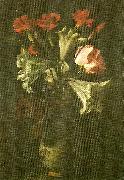Wholesale Oil Painting No Minimum |
|||||||||||
|
|
|||||||||||

|
|||||||||||
|
|
|
||||||||
Francisco de Zurbaran1598-1664 Spanish Francisco de Zurbaran Galleries Spanish baroque painter, active mainly at Llerena, Madrid, and Seville. He worked mostly for ecclesiastical patrons. His early paintings, including Crucifixion (1627; Art Inst., Chicago), St. Michael (Metropolitan Mus.), and St. Francis (City Art Museum, St. Louis), often suggest the austere simplicity of wooden sculpture. The figures, placed close to the picture surface, are strongly modeled in dramatic light against dark backgrounds, indicating the influence of Caravaggio. They were clearly painted as altarpieces or devotional objects. In the 1630s the realistic style seen in his famous Apotheosis of St. Thomas Aquinas (1631; Seville) yields to a more mystical expression in works such as the Adoration of the Shepherds (1638; Grenoble); in this decade he was influenced by Ribera figural types and rapid brushwork. While in Seville, Zurbur??n was clearly influenced by Velazquez. After c.1640 the simple power of Zurbaran work lessened as Murillo influence on his painting increased (e.g., Virgin and Child with St. John, Fine Arts Gall., San Diego, Calif.). There are works by Zurbar??n in the Hispanic Society of America, New York City; the National Gallery, Washington, D.C.; and the Philadelphia Museum of Art.. |
||||||||
|
|
||||||||
flower vase
flower vase Painting ID:: 65743 |
oil on canvas 44x34cm
se oil on canvas 44x34cm se |
|||||||
|
|
||||||||
|
Wilhelm Trubner German, 1851-1917 was a German realist painter of the circle of Wilhelm Leibl. Trubner was born in Heidelberg and had early training as a goldsmith. In 1867 he met classicist painter Anselm Feuerbach who encouraged him to study painting, and he began studies in Karlsruhe under Fedor Dietz. The next year saw him studying at the Kunstacademie in Munich, where he was to be greatly impressed by an international exhibition of paintings by Leibl and Gustave Courbet. Courbet visited Munich in 1869, not only exhibiting his work but demonstrating his alla prima method of working quickly from nature in public performances. This had an immediate impact on many of the city's young artists, who found Courbet's approach an invigorating alternative to the shopworn academic tradition. The early 1870s were a period of discovery for Tr??bner. He travelled to Italy, Holland and Belgium, and in Paris encountered the art of Manet, whose influence can be seen in the spontaneous yet restrained style of Trubner's portraits and landscapes. During this period he also made the acquaintance of Carl Schuch, Albert Lang and Hans Thoma, German painters who, like Trubner, greatly admired the unsentimental realism of Wilhelm Leibl. This group of artists came to be known as the "Leibl circle". He published writings on art theory in 1892 and 1898, which express above all the idea that "beauty must lie in the painting itself, not in the subject". By urging the viewer to discover beauty in a painting's formal values, its colors, proportions, and surface, Trubner advanced a philosophy of "art for art's sake". Flower Vase oil on canvas Dimensions 30 x 22.5 cm (11.8 x 8.9 in) cyf |
||||||||
|
|
||||||||
|
Prev Next
|
||||||||
|
|
||||||||
|
Related Paintings to Wilhelm Trubner :. |
||||||||
|
|
||||||||
|
CONTACT US |

